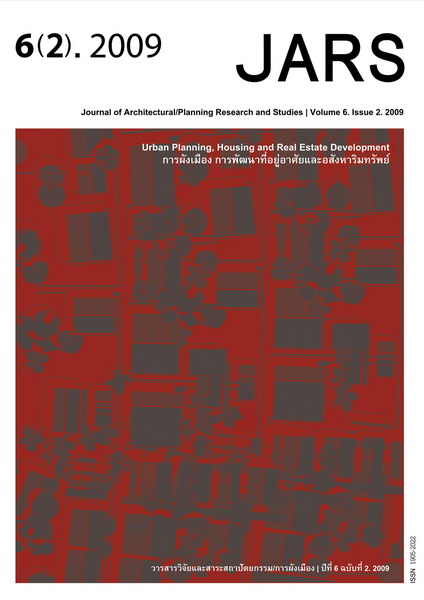Conservation and Development of Koh Kret Community Environment in Nonthaburi
Main Article Content
Abstract
The expansions of urbanization and economic growth over Bangkok area generate rapid changes on
several small communities surrounding Bangkok, especially on the potential ones such as Koh Kret, Nontahburi.
Due to its unique physical, social and cultural virtues, Koh Kret has been promoted as an eco-cultural tourist
attraction. This, to some extent, has impacts on Koh Kret’s physical transformations concerned with their original
way of life and cultures, causing the difficulties between retaining the cultural heritage and modernizing the
community area.
This research had studied on both theoretical and related topics along with a field research, focusing
on the studies for conservation and sustainable development of Koh Kret community environment related to the
tourism. Two main issues were covered in this research, that is, the community planning and the vernacular
architecture. In this study, the participating research was performed by using field surveys and questionnaires
for gathering information on community attitudes toward the above issues. This could be useful to identify the
solution approaches directed to the community problems. The approaches for conservation and development
of Koh Kret community environment as shown in this research could be further used to design a policy that can
be implemented in practical use for the community.
Downloads
Article Details

This work is licensed under a Creative Commons Attribution-NonCommercial-NoDerivatives 4.0 International License.
All material is licensed under the terms of the Creative Commons Attribution 4.0 International (CC-BY-NC-ND 4.0) License, unless otherwise stated. As such, authors are free to share, copy, and redistribute the material in any medium or format. The authors must give appropriate credit, provide a link to the license, and indicate if changes were made. The authors may do so in any reasonable manner, but not in any way that suggests the licensor endorses you or your use. The authors may not use the material for commercial purposes. If the authors remix, transform, or build upon the material, they may not distribute the modified material, unless permission is obtained from JARS. Final, accepted versions of the paper may be posted on third party repositories, provided appropriate acknowledgement to the original source is clearly noted.
References
Bunpook, P. (2000). ประวัติความเป็นมาของเกาะเกร็ด [History background of Koh Kret]. Nonthaburi, Thailand: Kwan Arman Cultural Center.
Division of Conservation, Tourism Authority of Thailnd (TAT). (2001). แผนปฏิบัติการการท่องเที่ยวเชิงนิเวศแห่งชาติ [Implement plan of national eco-tourism]. Bangkok, Thailand.
Jaijongrak, R. (1996). เรือนไทยเดิม [Thai traditional house]. Bangkok, Thailand: Thammasat University Press.
Lynch, K. (1960). The image of the city. Cambridge: MIT Press.
Panin, O. (1999). เรือนพื้นบ้านไทย-มอญ [Thai-Mon vernacular house]. Bangkok, Thailand: Research and Development Institute, Silpakorn University.
Phattanawasin, S. (2004). การศึกษาเพื่ออนุรักษ์และพัฒนาลักษณะสภาพแวดล้อมชุมชนท้องถิ่นเกาะเกร็ด จังหวัดนนทบุรี [The studies for conservation and development of Koh Kret community environment in Nonthaburi]. Final research report under the research grant from the National Research Council of Thailand. Pathum Thani, Thailand: Faculty of Architecture and Planning, Thammasat University.
Pirom, E. (1999). เกาะเกร็ด [Koh Kret]. Nonthaburi, Thailand: Wat Poramaiyikavas.
Ruano, M. (1999). EcoUrbanism – Sustainable human settlements: 60 case studies. Barcelona, Spain: Ingoprint.
Swarbrooke, J. (2000). Sustainable tourist management. New York: CABI Publishing.
Thadaniti, S. (2002). Towards sustainable eco-cultural tourism for water-based settlements on the banks of Chao Phraya River: Ko Kret, Case study Nonthaburi Province, Thailand. Manusya: Journal of Humanities, Special Issue, 3, 81-88.
Uruchata, P. (2003). วัดปรมัยยิกาวาส [Wat Poramaiyikavas]. Bangkok, Thailand: Muang Boran Publishing.
Vichayaprasertkul, S. (2002). แนวทางการพัฒนาการท่องเที่ยวอย่างยั่งยืนของเกาะเกร็ด จังหวัดนนทบุรี [Guideline for sustainable tourism development in Koh Kret, Nonthaburi]. Master Thesis, Faculty of Architecture, Chulalongkorn University, Bangkok, Thailand.


